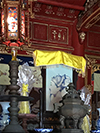|
Tu Duc (Tự Đức)
Vietnamese. Name of the fourth Emperor of the Nguyen (Nguyễn) Dynasty, who reigned from 1847 to 1883 AD. He is fully known as Nguyen Phuc Hong Nham (Nguyễn Phúc Hồng Nhậm), and is also referred to as Nguyen Phuc Thi (Nguyễn Phúc Thì). He is by some regarded as the last Emperor of
Vietnam, as he was the last to rule autonomously. Though described as a gentle and educated man, he oppressed all foreigners in Vietnam, especially the
Christian community. His policies resulted in France attacking southern Vietnam with a large military expeditionary force. With their modern tactics and weapons the French quickly advanced and Tu Duc called upon his Manchu overlord the Qing Emperor Zai Tian for help, which led to the Sino-French War that began with a surprise attack by the French on the Chinese southern fleet at Fuzhou. France thus fought against
China and the Black Flag Army, i.e. the splinter remnant of a bandit group recruited largely from soldiers of the ethnic Zhuang, who joined the Vietnamese regular forces in order to fight and hold back French encroachment beyond the
Red River (fig.) Delta area. Though tormented by the climate and disease, the military superiority of the French eventually made them victorious and the war ended in 1885 with the Treaty of Tientsin, in which China gave up its position as feudal master of Vietnam and recognized the French protectorate in Vietnam. A case of smallpox had left Tu Duc impotent and childless, so after his death he was succeeded by his adopted son Duc Duc (Dục Đức), i.e. his cousin and the second son of his fourth brother. However, a power struggle soon emerged at the imperial court and the 31 year old newly enthroned Emperor was deposed by court officials after a reign of only three days. Though Tu Duc was buried at a secret location, he has a
cenotaph tomb on the outskirts of Hue (fig.), as well as a memorial altar (fig.) among the other Nguyen Emperors inside the Citadel in Hue (fig.).
回






|

